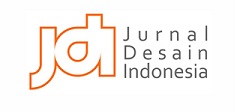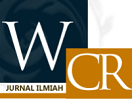STUDI TATA PAJANG KERIS PADA MUSEUM PUSAKA, TAMAN MINI INDONESIA INDAH
Abstract
The purpose of this research is to find a good and interesting collection system of the heirlooms at museum as to provide the visitors with an appeal and clarity information about collections in Museum as a public spaces. The background of this research is looking at the condition of Heritage Museum which looks like been abandoned and not neatly arranged, we concern about the suistainablity of collections’s display that are not maintained well. They need to be upgraded for a display system to be more interesting and easily seen. Especially the ancient museums of heirlooms which is keris that are not quite interesting for youngster nowaday due to the proliferation of contemporary museums. Therefor it is our duty to make the museum look more interesting to be visited and show much more information to the visitors. However, there are many aspects that need to be considered in designing good museum display, while many supporting factors such as the grouping of collections, the signage systems, as well as lighting are needed too. This study will examine how the object of research solves the issue above and researchers will provide appropriate and better display system as the solution, hoping that it will increase the interest and attention of visitors to know the museum colletion better. The method used in the research are documentation of the research object, combined with the study of literature. Hopefully this research will give contribution to the design of the museum's display system with ergonomical and clearly information about the collection, also gives happiness to the wider community. For the further development of museums, this research is aimed to contributes a good and friendly display technique and system in the future.
Keywords
Full Text:
PDF (Bahasa Indonesia)References
Ahmad, S., Abbas, M. Y., Taib, M. Z. M., & Masri, M. (2014). Museum Exhibition Design: Communication of Meaning and the Shaping of Knowledge.
Procedia - Social and Behavioral Sciences, 153, 254–265. DOI https://doi.org/10.1016/j.sbspro.2014.10.059
Çıldır, Z., & Karadeniz, C. (2014). Museum, Education and Visual Culture Practices: Museums in Turkey.
American Journal of Educational Research, 2(7), 543–551. DOI: https://doi.org/10.12691/education-2-7-18
McLean, K. (1993). Planning for People in Museum Exhibitions.
Washington: Association of Science-Technology Centers.
Nickols, F & Ledgerwood R. (2005). The Goals Grid: A New Tool for Strategic Planning available visited on web https://www.nickols.us/strategic_planning_tool.pdf
Salim, P. (2018). Persepsi Kualitas Ruang Pamer Museum Seni: Sebuah Studi Observasi. NARADA Jurnal Desain dan Seni. 5(1)
Lelo,L & Laksono, M, A. (2018). Perancangan Desain Interior Museum Seni Rupa Dan Keramik Jakarta. NARADA Jurnal Desain dan Seni. 5(1)
Sutalaksana, I. Z. (1979). Teknik Tata Cara Kerja. Bandung: Penerbit ITB.
Urry, J. (2002). The Tourist Gaze: Leisure and Travel in Contemporary Societies (2nd ed.). London: Sage Publications.
Wulandari, A. A. A. (2013). Taman Mini Indonesia Indah: Education or Entertainment?. Humaniora, 4 (1), 156. DOI: https://doi.org/10.21512/humaniora.v4i1.3425
Wulandari, A. A. A., & Ruki, U. A. (2018). Education and Exhibition Display Design in Taman Mini Indonesia Indah. Humaniora, 9 (2), 199. DOI: https://doi.org/10.21512/humaniora.v9i2.4597
DOI: http://dx.doi.org/10.22441/narada.2020.v7.i1.001
Refbacks
- There are currently no refbacks.
Fakultas Desain dan Seni Kreatif
Universitas Mercu Buana
Gedung E Lantai 4
Jl. Raya Meruya Selatan no.1, Kembangan, Jakarta 11650
Tlp./Fax: +62215871335
Journal International Standard Serial Number (ISSN) Registration:
The Journal is indexed by:
Tools for Citations & Plagiarism Detection:

Ciptaan disebarluaskan di bawah Lisensi Creative Commons Atribusi-NonKomersial 4.0 Internasional
 NARADA: Jurnal Desain dan Seni
NARADA: Jurnal Desain dan Seni

























